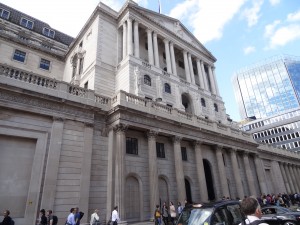 We have reported frequently in our blogs about concerns over rising debt levels among UK households. We previously noted the concerns expressed in July 2014 by the Prudential Regulation Authority (PRA) that the growth in consumer credit (unsecured lending) was stretching the financial well-being of individuals with implications for the resilience of lenders’ credit portfolios. Now the Chief Executive of the Financial Conduct Authority (FCA), Andrew Bailey, in an interview to the BBC has identified the growing problem of debt among young people.
We have reported frequently in our blogs about concerns over rising debt levels among UK households. We previously noted the concerns expressed in July 2014 by the Prudential Regulation Authority (PRA) that the growth in consumer credit (unsecured lending) was stretching the financial well-being of individuals with implications for the resilience of lenders’ credit portfolios. Now the Chief Executive of the Financial Conduct Authority (FCA), Andrew Bailey, in an interview to the BBC has identified the growing problem of debt among young people.
In his interview Mr Bailey stresses that the growth in debt amongst younger people is not ‘reckless borrowing’ and so not borne out of a lack of willpower or ‘present bias’ (see John’s blog Nudging mainstream economists). Rather, it is borrowing simply to meet basic living costs.
In his interview Mr Bailey goes on to identify generational shifts in patterns of wealth and debt. He notes:
There are particular concentrations [of debt] in society, and those concentrations are particularly exposed to some of the forms and practices of high cost debt which we are currently looking at very closely because there are things in there that we don’t like.
There has been a clear shift in the generational pattern of wealth and income, and that translates into a greater indebtedness at a younger age. That reflects lower levels of real income, lower levels of asset ownership. There are quite different generational experiences.
 Mr Bailey goes on to echo concerns expressed back in July by the Prudential Regulation Authority in relation to the growth in consumer credit. The chart illustrates the scale of the accumulation of consumer credit (unsecured lending) across all individuals in the UK. In August 2017 the stock of unsecured debt rose to £203 billion, the highest level since December 2008 when the financial crisis was unfolding. (Click here to download a PowerPoint of the chart).
Mr Bailey goes on to echo concerns expressed back in July by the Prudential Regulation Authority in relation to the growth in consumer credit. The chart illustrates the scale of the accumulation of consumer credit (unsecured lending) across all individuals in the UK. In August 2017 the stock of unsecured debt rose to £203 billion, the highest level since December 2008 when the financial crisis was unfolding. (Click here to download a PowerPoint of the chart).
In concluding his BBC interview, Mr Bailey notes that credit should be available to younger people. Credit helps individuals to ‘smooth income’ and that this is something which is increasingly important with more people having erratic incomes as the gig-economy continues to grow. However, he notes that credit provision needs to be “sustainable”.
BBC Interview
Financial regulator warns of growing debt among young people BBC News (16/10/17)
Articles
Young people are borrowing to cover basic living costs, warns City watchdog Guardian, Julia Kollewe (16/10/17)
Britain’s debt timebomb: FCA urges action over £200bn crisis Guardian, Phillip Inman and Jill Treanor (18/9/17)
FCA warning that young are borrowing to eat shames Britain Independent, James Moore (16/7/17)
Young people are ‘borrowing to cover basic living costs’ and increasing numbers are going bankrupt, warns financial watchdog Daily Mail, Kate Ferguson (6/10/17)
More and more young people are falling into debt – but it’s not their fault Metro, Alex Simpson (20/10/17)
Data
Bankstats (Monetary and Financial Statistics) – Latest Tables Bank of England
Statistical Interactive Database Bank of England
Questions
- What does it mean if people are financially distressed?
- What do you think Mr Bailey means by ‘sustainable credit’?
- In what ways might levels of debt impact on the macroeconomy?
- How does credit help to smooth spending patterns? Why might this be more important with the growth in the gig-economy?
- What is meant by inter-generational fairness?
- Of what relevance are changing patterns in wealth and debt to inter-generational fairness? What factors might be driving these patterns?
- What sort of credit is unsecured credit? How does it differ from secured credit?
- Are there measures that policymakers can take to reduce the likelihood that flows of credit become too excessive?
 An economy that becomes dependent on credit can, in turn, become acutely volatile. Too much credit and there exists the potential for financial distress which can result in an economic slowdown as people cut back on spending. Too little credit and the growth in aggregate demand is subdued. Some argue that this is what now faces a financialised economy like the UK. Even it this overstates the significance of credit, there is no doubt that UK credit data is keenly followed by economists and policymakers.
An economy that becomes dependent on credit can, in turn, become acutely volatile. Too much credit and there exists the potential for financial distress which can result in an economic slowdown as people cut back on spending. Too little credit and the growth in aggregate demand is subdued. Some argue that this is what now faces a financialised economy like the UK. Even it this overstates the significance of credit, there is no doubt that UK credit data is keenly followed by economists and policymakers.
Recent rates of credit accumulation by individuals have raised concern. In July 2014 the Prudential Regulation Authority (PRA) of the Bank of England issued a statement voicing its concern that the growth in consumer credit, also known as unsecured lending, was stretching the financial well-being of individuals and that the resilience of lenders’ consumer credit portfolios was therefore reducing.
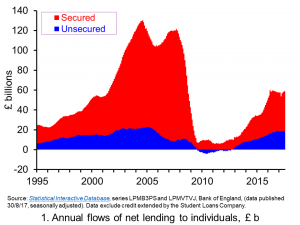 Chart 1 illustrates the scale of the flows of both consumer credit (unsecured lending) and mortgages (secured credit) from banks and building societies to individuals. It shows the amount of credit net of repayments lent over the last 12 months. In the 12 months to July 2017 the net accumulation of consumer credit was £18.2 billion while that of secured borrowing was £40.8 billion. Although the 12-month level of consumer credit accumulation was down from its recent peak of £19.2 billion in November 2016, total net lending (including secured lending) to individuals of £59.0 billion was its highest since September 2008. (Click here to download a PowerPoint of the chart).
Chart 1 illustrates the scale of the flows of both consumer credit (unsecured lending) and mortgages (secured credit) from banks and building societies to individuals. It shows the amount of credit net of repayments lent over the last 12 months. In the 12 months to July 2017 the net accumulation of consumer credit was £18.2 billion while that of secured borrowing was £40.8 billion. Although the 12-month level of consumer credit accumulation was down from its recent peak of £19.2 billion in November 2016, total net lending (including secured lending) to individuals of £59.0 billion was its highest since September 2008. (Click here to download a PowerPoint of the chart).
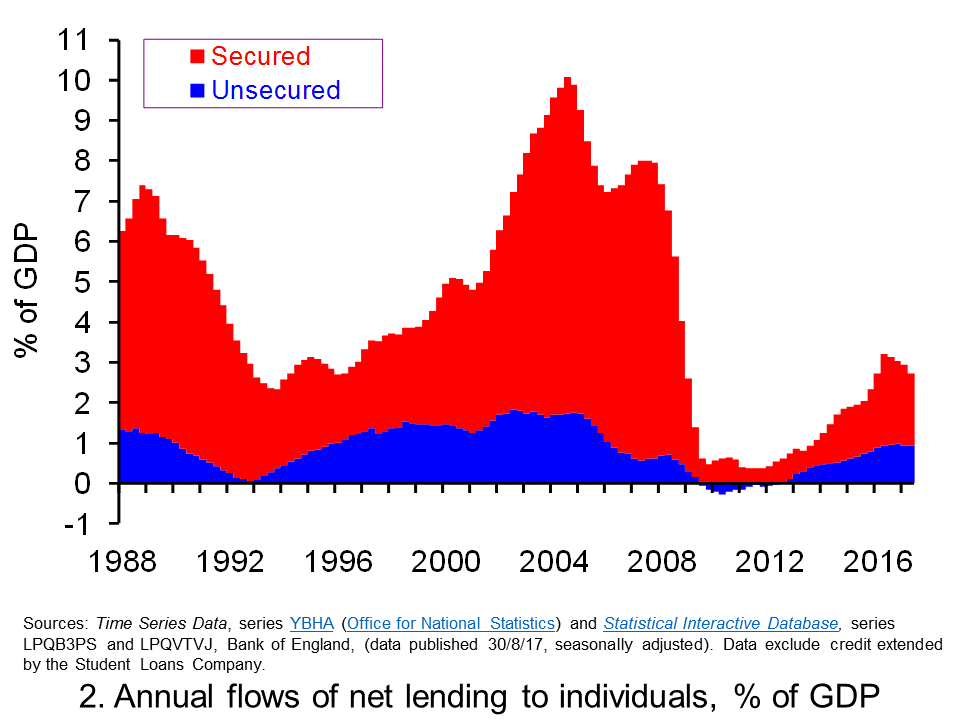 To help put in context the size of flows of net lending Chart 2 shows the annual flows of consumer credit and secured debt as percentages of GDP. In this case each observation measures net lending over the past four quarters as a percentage of annual GDP. The latest observation is for 2017 Q2 and shows that the annual net flow of consumer credit was equivalent to 0.94 per cent of GDP while that for secured borrowing was 1.78 per cent of GDP. While the flows of consumer credit and secured borrowing as shares of national income have eased a little from their values in the second half of last year, they have not eased significantly. (Click here to download a PowerPoint of the chart).
To help put in context the size of flows of net lending Chart 2 shows the annual flows of consumer credit and secured debt as percentages of GDP. In this case each observation measures net lending over the past four quarters as a percentage of annual GDP. The latest observation is for 2017 Q2 and shows that the annual net flow of consumer credit was equivalent to 0.94 per cent of GDP while that for secured borrowing was 1.78 per cent of GDP. While the flows of consumer credit and secured borrowing as shares of national income have eased a little from their values in the second half of last year, they have not eased significantly. (Click here to download a PowerPoint of the chart).
 Despite the recent strength of borrowing, levels are nothing like those seen in the mid 2000s. Nonetheless, we need to see the current accumulation of debt in the context of two important factors: debt already accumulated and the future macroeconomic environment. Chart 3 gives some insight to the first of these two by looking at stocks of debt outstanding as shares of GDP. The total debt-to-GDP ratio peaked 90 percent in 2009 before relatively slower growth in credit accumulation saw the ratio fall back. The ratio has now been at or around the 78 per cent level consistently for the past two or so years. (Click here to download a PowerPoint of the chart).
Despite the recent strength of borrowing, levels are nothing like those seen in the mid 2000s. Nonetheless, we need to see the current accumulation of debt in the context of two important factors: debt already accumulated and the future macroeconomic environment. Chart 3 gives some insight to the first of these two by looking at stocks of debt outstanding as shares of GDP. The total debt-to-GDP ratio peaked 90 percent in 2009 before relatively slower growth in credit accumulation saw the ratio fall back. The ratio has now been at or around the 78 per cent level consistently for the past two or so years. (Click here to download a PowerPoint of the chart).
The ratio of the stock of consumer debt to GDP peaked in 2008 at 13.3 per cent. It too fell back reaching 9.05 per cent in the middle of 2014. Since that time the ratio has been rising and by the end of the second quarter of this year was 10.1 per cent. The PRA appears not only to be concerned by this but also the likely unwinding of what it describes as the ‘current benign macroeconomic environment and historically low arrears rates’.
Going forward, we might expect to see ever closer scrutiny not only of the aggregate indicators referred to here but of an array of credit indicators. The PRA statement, for example, refers to the number of , ‘0% interest credit card offers’, falling interest rates on unsecured personal loans and the growth of motor finance loans. The hope is that we can avoid the costs of financial distress that so starkly affected the economy in the late 2000s and that continue to cast a shadow over today’s economic prospects.
PRA Statement
PRA Statement on Consumer Credit PRA, Bank of England (4/7/14)
Articles
Bank of England demands consumer credit vigilance; construction growth slows – as it happened Guardian (4/7/14)
Bank of England warns more defences may be needed against consumer credit Telegraph (24/7/17)
Beware the bubble: Bank of England clamps down on credit Telegraph, Tim Wallace (1/7/17)
Bank of England raises capital requirements on UK lenders amid concerns about excessive consumer borrowing Independent, Ben Chu (27/6/17)
Bank of England tightens mortgage borrowing rules amid fears of debt boom Express, Lana Clements (27/6/17)
Rise in personal loans dangerous, Bank of England official says BBC News (25/7/17)
Bank of England takes action over bad loans BBC News (27/6/17)
Data
Bankstats (Monetary and Financial Statistics) – Latest Tables Bank of England
Statistical Interactive Database Bank of England
Questions
- What does it mean if people are financially distressed? What responses might people take in response to this distress?
- How can financial distress affect the economy’s growth path?
- How would you measure the financial well-being of an individual? What about the financial well-being of firms?
- What role mights banks play in affecting levels of financial distress in the economy?
- What does it mean if credit conditions are pro-cyclical?
- Why might banks’ lending be pro-cyclical?
- Are there measures that policymakers can take to reduce the likelihood that flows of credit become too excessive?
- Why do some economists refer to the economic downturn of the late 2000s as a balance sheet recession? How likely is another balance sheet recession in the short term? What about in the longer term?
 The Bank of England’s Money and Credit release on 1 Feb provides us with data up to the end of 2015 on lending by banks and building societies to the rest of the UK private sector. In this post we update our blog of 17 December 2015 – is Minsky right yet again? – to analyse the latest data on lending. The headline numbers show that the flow of lending (net of repayments) by banks and building societies to UK households in 2015 was £40.8 billion up from £29.9 billion in 2014 taking their amount of outstanding lending to households to £1.26 trillion. Was American economist Minsky (1919-1996) right to have argued that cycles in credit are inevitable?
The Bank of England’s Money and Credit release on 1 Feb provides us with data up to the end of 2015 on lending by banks and building societies to the rest of the UK private sector. In this post we update our blog of 17 December 2015 – is Minsky right yet again? – to analyse the latest data on lending. The headline numbers show that the flow of lending (net of repayments) by banks and building societies to UK households in 2015 was £40.8 billion up from £29.9 billion in 2014 taking their amount of outstanding lending to households to £1.26 trillion. Was American economist Minsky (1919-1996) right to have argued that cycles in credit are inevitable?
 Chart 1 shows the stocks of debt acquired by both households and private non-financial corporations from MFIs (Monetary Financial Institutions), i.e. deposit-taking institutions. The scale of debt accumulation in the late 1980s and again from the mid 1990s up to the financial crisis of the late 2000s is stark. At the start of 1980 the UK household sector had debts to MFIs of around £53 billion. By the start of 2009 this had hit £1.29 trillion. To put these figures into context this corresponds to an increase in indebtedness to MFIs from 25 per cent of GDP to 86 per cent of GDP.
Chart 1 shows the stocks of debt acquired by both households and private non-financial corporations from MFIs (Monetary Financial Institutions), i.e. deposit-taking institutions. The scale of debt accumulation in the late 1980s and again from the mid 1990s up to the financial crisis of the late 2000s is stark. At the start of 1980 the UK household sector had debts to MFIs of around £53 billion. By the start of 2009 this had hit £1.29 trillion. To put these figures into context this corresponds to an increase in indebtedness to MFIs from 25 per cent of GDP to 86 per cent of GDP.
The chart also shows the increase in indebtedness of private non-financial corporations which are effectively every day businesses. They saw their debts to MFIs rise from around £25 billion to over £500 billion which is equivalent to an increase from 12 per cent of GDP to 33 per cent of GDP. (Click here to download a PowerPoint of Chart 1.)
The path of debt at the start of the 2010s is consistent with a story of consolidation. Although the term is readily used in the context of the public sector and measures to reduce public-sector deficits the term is also relevant for the private sector. Financially-distressed households, private non-financial corporations and MFIs took steps to repair their balance sheets following the financial crisis. Indeed the term is synonymous with the idea of a balance sheet recession which some economists argue describe the late 2000s. The result was that the demand for and supply of additional credit waned. Debt accumulation largely ceased and, as we can see from Chart 1, debt numbers fell.
More recently the indebtedness to MFIs of households has started to edge up again, though, as yet, not for private non-financial corporations. From the end of the first quarter of 2013 to the end of 2015 household indebtedness to MFIs has increased by 7 per cent to £1.26 trillion.
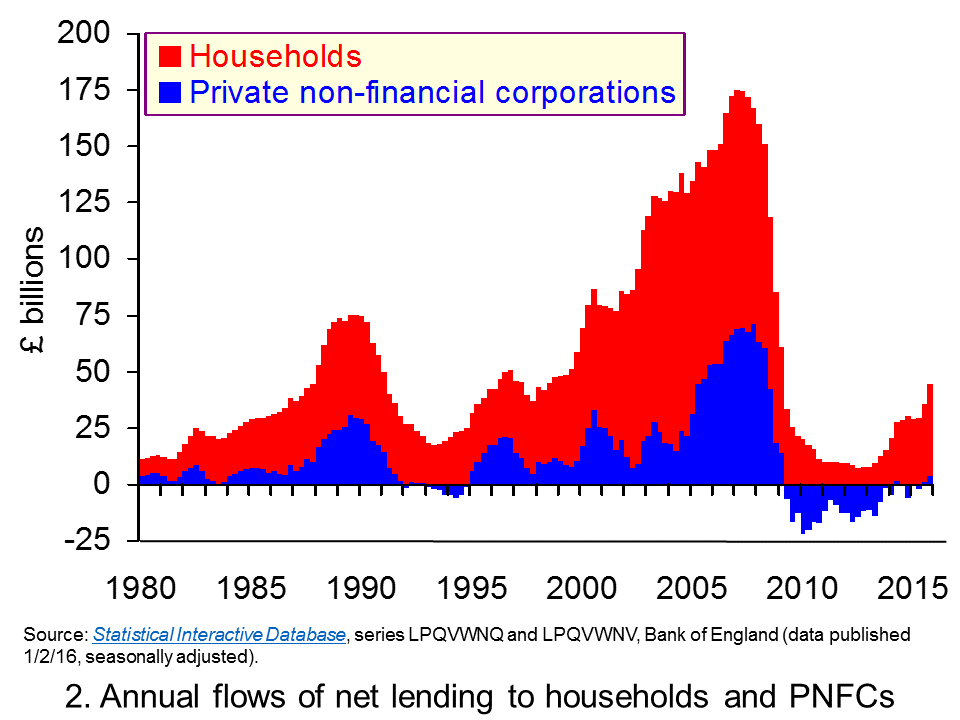 Chart 2 focuses on flows rather than stocks. (Click here to download a PowerPoint of Chart 2.) It allows us to see the accumulation of new credit (i.e. less repayments of debt). What is even more apparent from this chart is the evidence of cycles in credit. The growth in new credit during the 2000s is stark as is the subsequent squeeze on credit that followed. Across 2006 net flows of credit from MFIs to households reached £106 billion while the peak for PNFCs was across 2007 when they reached £71 billion. Subsequently, net credit numbers crashed with negative numbers for PNFCs indicating net repayments to MFIs.
Chart 2 focuses on flows rather than stocks. (Click here to download a PowerPoint of Chart 2.) It allows us to see the accumulation of new credit (i.e. less repayments of debt). What is even more apparent from this chart is the evidence of cycles in credit. The growth in new credit during the 2000s is stark as is the subsequent squeeze on credit that followed. Across 2006 net flows of credit from MFIs to households reached £106 billion while the peak for PNFCs was across 2007 when they reached £71 billion. Subsequently, net credit numbers crashed with negative numbers for PNFCs indicating net repayments to MFIs.
The size of the credit flows emanating from MFIs and the magnitude of the resulting credit cycles is even more stark when presented as percentages of GDP. The annual flow of credit to households in the late 1980s reached 9.4 per cent of GDP while that to PNFCs peaked at the end of the decade at 5.2 per cent of GDP. Meanwhile, across 2006 net credit to households reached 7.5 per cent of GDP while the peak of lending to PNFCs was in the 12-month period to the end of 2007 Q1 equivalent to 4.8 per cent of GDP. In 2015, credit from MFIs to households reached 2.2 per cent of GDP while that to PNFCs was a mere 0.2 per cent of GDP.
Of course, the key question now is the path of credit. Clearly flows of credit to households are again on the rise. In part, this is driven by the rebound in the UK housing market. But, significantly there has been a significant rise in flows of consumer credit, i.e. unsecured debt.
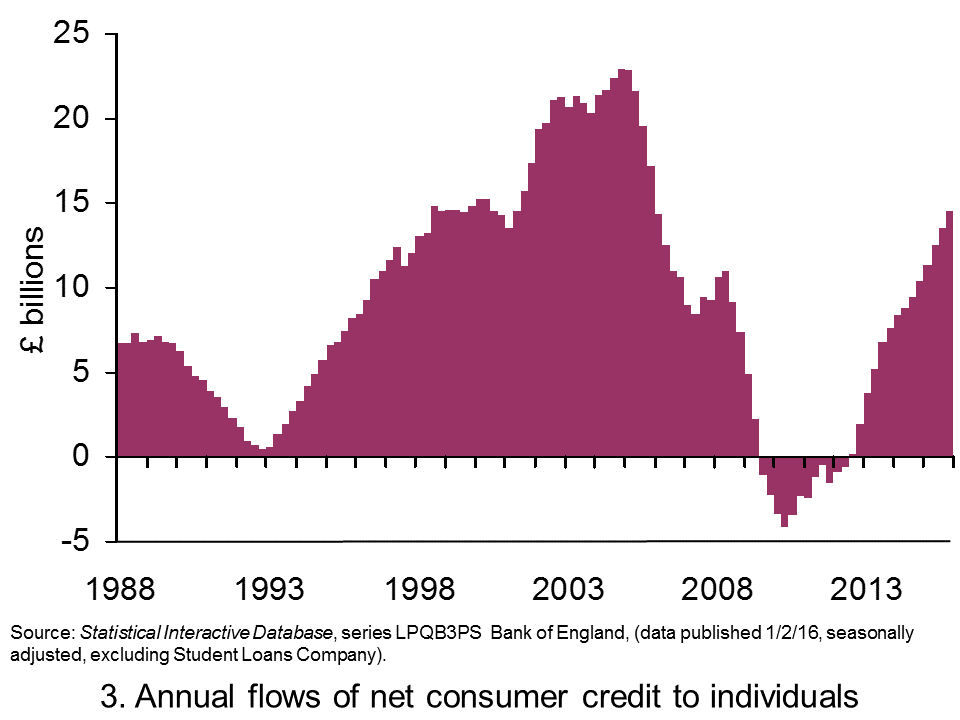 Chart 3 shows the flows of consumer credit to individuals (excluding student loans involving the Student Loans Company) from MFIs and other credit providers. Again, we see the marked evidence of cycles. Across 2015 these net consumer credit flows amounted to £14.5 billion, the highest annual figure since 2005. (Click here to download a PowerPoint of the chart.)
Chart 3 shows the flows of consumer credit to individuals (excluding student loans involving the Student Loans Company) from MFIs and other credit providers. Again, we see the marked evidence of cycles. Across 2015 these net consumer credit flows amounted to £14.5 billion, the highest annual figure since 2005. (Click here to download a PowerPoint of the chart.)
To put the current rise in consumer credit into context, the net flow of consumer credit to individuals as percentage of GDP across 2015 as a whole amounts to about 0.8 per cent of GDP. This is the highest figure since the second half of 2006. While it might be a little early to say that credit numbers are a cause for concern, they do need to be seen in the context of a still relatively highly indebted household sector. Policymakers will be keeping a keen eye on credit patterns and assessing whether we have again acquired a real appetite for credit.
Articles
Households put another £4.4 billion on credit cards and personal loans in December as debt rises at fastest pace in a decade ThisisMoney.co.uk, Rachel Rickard Straus (1/2/16)
One in four ‘living for the day’ as 700,000 more expected to default on debt Independent, Simon Read (2/1/16)
Surprise mortgage jump confounds expectations Independent, Russell Lynch (1/2/16)
U.K. consumer credit slows; mortgage approvals up MarketWatch, Jon Sindreu (1/2/16)
Family debt continues to rise – report BBC News (13/1/16)
Data
Bankstats (Monetary and Financial Statistics) – Latest Tables Bank of England
Statistical Interactive Database Bank of England
Questions
- How can the financial system affect the economy’s business cycle?
- What does it mean if households or firms are financially distressed? What responses might they take to this distress and what might the economic consequences be?
- How would you measure the net worth (or wealth) of an individual or a firm? What factors might affect their net worth?
- How might uncertainty affect spending and saving by households and businesses?
- What does it mean if bank lending is pro-cyclical?
- Why might lending be pro-cyclical?
- Are there measures that policymakers can take to reduce the likelihood that flows of credit become too excessive?
- What do you understand by a consolidation by the private sector? Discuss the possible macroeconomic effects of such a consolidation.
- What is meant by a balance sheet recession?
- How might the effect of attempts by a large number of individuals to improve their financial well-being differ from those when only a small numbers of individuals do so?
 To what extent does history repeat itself? Minsky’s Financial Instability Hypothesis infers that credit cycles are fairly inevitable. We have seem them in the past and we will see them in the future. Human beings are subject to emotion, to irrational exuberance and to a large dose of forgetfulness! To what extent do the latest UK credit numbers suggest that we might be embarking on another credit binge? Are the credit data consistent with evidence of another credit cycle?
To what extent does history repeat itself? Minsky’s Financial Instability Hypothesis infers that credit cycles are fairly inevitable. We have seem them in the past and we will see them in the future. Human beings are subject to emotion, to irrational exuberance and to a large dose of forgetfulness! To what extent do the latest UK credit numbers suggest that we might be embarking on another credit binge? Are the credit data consistent with evidence of another credit cycle?
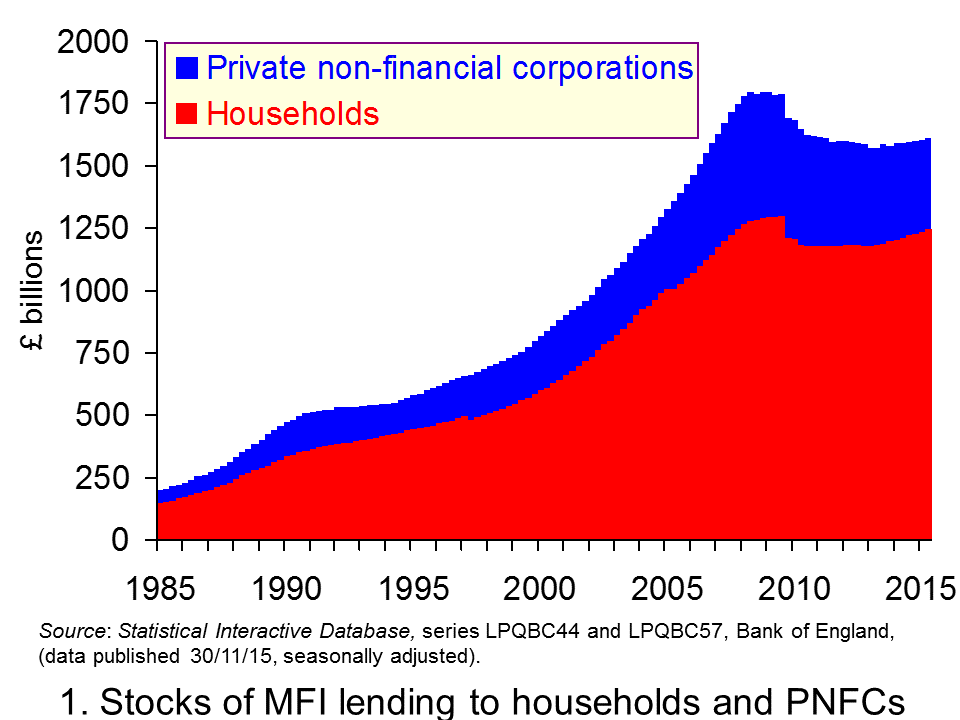 Chart 1 shows the stocks of debt acquired by households and private non-financial corporations from MFIs (Monetary Financial Institutions). The scale of debt accumulation in the late 1980s and again from the mid 1990s up to the financial crisis of the late 2000s is stark. At the start of 1985 the UK household sector had debts to MFIs of around £140 billion. By the start of 2009 this had hit £1.29 trillion. Meanwhile, private non-financial corporations saw their debts to MFIs rise from around £45 billion to over £500 billion. (Click here to download a PowerPoint of the chart.)
Chart 1 shows the stocks of debt acquired by households and private non-financial corporations from MFIs (Monetary Financial Institutions). The scale of debt accumulation in the late 1980s and again from the mid 1990s up to the financial crisis of the late 2000s is stark. At the start of 1985 the UK household sector had debts to MFIs of around £140 billion. By the start of 2009 this had hit £1.29 trillion. Meanwhile, private non-financial corporations saw their debts to MFIs rise from around £45 billion to over £500 billion. (Click here to download a PowerPoint of the chart.)
The path of debt at the start of the 2010s is consistent with a story of consolidation. Financially-distressed households, private non-financial corporations and, of course, MFIs themselves meant that corrective action was needed to repair their balance sheets. The demand for and supply of additional credit waned. Debt accumulation largely ceased and, in fact, debt numbers fell. This trend continues today for private non-financial corporations. But, for households debt accumulation resumed in the middle of 2013. At the end of the third quarter of 2015 the household sector had debt obligations to MFIs of £1.246 trillion.
 Chart 2 focuses on flows rather stocks. It allows us to see the accumulation of new credit (i.e. less repayments of debt). What is even more apparent from this chart is the evidence of cycles in credit. The growth in new credit during the 2000s is stark as is the subsequent squeeze on credit that followed.
Chart 2 focuses on flows rather stocks. It allows us to see the accumulation of new credit (i.e. less repayments of debt). What is even more apparent from this chart is the evidence of cycles in credit. The growth in new credit during the 2000s is stark as is the subsequent squeeze on credit that followed.
The question that follows is what path are we now on? Clearly flows of credit to households are again on the rise. In part, this is driven by the rebound in the UK housing market. But, in fact there is a more rapid increase in consumer credit, i.e. unsecured debt. (Click here to download a PowerPoint of the chart.)
 Chart 3 shows the flows of consumer credit from MFIs and other credit providers. Again, we see the marked evidence of cycles. In the year to the end of Q1 of 2015 net consumer credit flows amounted to £22.8 billion, the highest figure since the 12-month period up to the end of Q3 of 2005. Click here to download a PowerPoint of the chart.)
Chart 3 shows the flows of consumer credit from MFIs and other credit providers. Again, we see the marked evidence of cycles. In the year to the end of Q1 of 2015 net consumer credit flows amounted to £22.8 billion, the highest figure since the 12-month period up to the end of Q3 of 2005. Click here to download a PowerPoint of the chart.)
While it might be a little early to say that another Minsky cycle is well under way, policymakers will be keeping a keen eye on credit patterns. Is history repeating itself?
Articles
Average UK mortgage debt rises to £85,000 The Guardian, Phillip Inman (15/12/15)
Consumer spending rise troubles Bank of England The Guardian, Heather Stewart (24/11/15)
Recovery ‘too reliant on consumer debt’ as BCC downgrades forecast The Guardian, Heather Stewart (9/12/15)
BCC: UK Growth Too Reliant On Consumer Debt Sky News (9/12/15)
Interest rates will stay low for longer – but household debt is a worry, says BoE The Telegraph, Szu Ping Chan (24/11/15)
IMF: UK’s economic performance ‘very strong’, but risks remain BBC News (11/12/15)
Data
Bankstats (Monetary and Financial Statistics) – Latest Tables Bank of England
Statistical Interactive Database Bank of England
Questions
- How can the financial system affect the economy’s business cycle?
- What does it mean if households or firms are financially distressed? What responses might they take to this distress and what might the economic consequences be?
- How would you measure the net worth (or wealth) of an individual or a firm? What factors might affect their net worth?
- How might uncertainty affect spending and saving by households and businesses?
- What does it mean if bank lending is pro-cyclical?
- Why might lending be pro-cyclical?
- Are there measures that policymakers can take to reduce the likelihood that flows of credit become too excessive?
 We have reported frequently in our blogs about concerns over rising debt levels among UK households. We previously noted the concerns expressed in July 2014 by the Prudential Regulation Authority (PRA) that the growth in consumer credit (unsecured lending) was stretching the financial well-being of individuals with implications for the resilience of lenders’ credit portfolios. Now the Chief Executive of the Financial Conduct Authority (FCA), Andrew Bailey, in an interview to the BBC has identified the growing problem of debt among young people.
We have reported frequently in our blogs about concerns over rising debt levels among UK households. We previously noted the concerns expressed in July 2014 by the Prudential Regulation Authority (PRA) that the growth in consumer credit (unsecured lending) was stretching the financial well-being of individuals with implications for the resilience of lenders’ credit portfolios. Now the Chief Executive of the Financial Conduct Authority (FCA), Andrew Bailey, in an interview to the BBC has identified the growing problem of debt among young people. Mr Bailey goes on to echo concerns expressed back in July by the Prudential Regulation Authority in relation to the growth in consumer credit. The chart illustrates the scale of the accumulation of consumer credit (unsecured lending) across all individuals in the UK. In August 2017 the stock of unsecured debt rose to £203 billion, the highest level since December 2008 when the financial crisis was unfolding. (Click here to download a PowerPoint of the chart).
Mr Bailey goes on to echo concerns expressed back in July by the Prudential Regulation Authority in relation to the growth in consumer credit. The chart illustrates the scale of the accumulation of consumer credit (unsecured lending) across all individuals in the UK. In August 2017 the stock of unsecured debt rose to £203 billion, the highest level since December 2008 when the financial crisis was unfolding. (Click here to download a PowerPoint of the chart).








